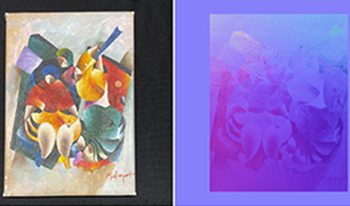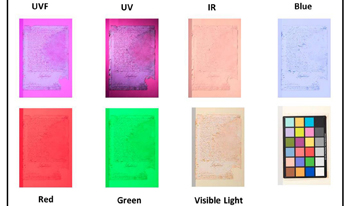
In this paper we introduce MISHA3D, a set of tools that enable 3D surface capture using the MISHA multispectral imaging system. MISHA3D uses a novel multispectral photometric stereo algorithm to estimate normal, height, and RGB albedo maps as part of the standard multispectral imaging workflow. The maps can be visualized and analyzed directly, or rendered as realistic, interactive digital surrogates using standard graphics APIs. Our hope is that these tools will significantly increase the usefulness of the MISHA system for librarians, curators, and scholars studying historical and cultural heritage artifacts.

Multispectral Imaging has become an indispensable tool for Cultural Heritage materials and objects analyzing, documenting, and visualizing. This study delves into applying this technique to an 18th-century illuminated manuscript at the Minas Gerais Public Archive, Brazil. Currently undergoing restoration intervention at The Federal University of Minas Gerais, the manuscript exhibits faded writing due to moisture, and the application of multispectral imaging (UV, Visible, and IR) with seven different wavelengths proves highly effective in recovering lost information. The light source was provided from LED and Halogen Lamp, and the result shows a very clear text on the manuscript after the digital processing by ImageJ and PCA. The Minas Gerais Public Archive, established in 1895, plays a vital role in safeguarding the state's documentary and historical heritage. It was the first-time multispectral imaging was applied to cultural objects in Minas Gerais.

Historic properties face challenges preserving and maintaining their physical heritage, as well as digitally sharing and accessing their history in a virtual environment. They are now utilizing new advanced imaging methods to research their cultural heritage artifacts. Recent advanced imaging in historic Civil War-era houses demonstrated the integration of imaging techniques and data to support conservation of these structures and research into their history and contents. New technical systems, including the latest narrowband multispectral imaging systems and higher resolution cameras, raise major challenges in not only the integration of new technologies, but also the ability to store, manage and access large amounts of data. Integration, preservation, access and collaboration with the image data from this program requires implementation of standardized digitization and data archiving practices.

We publish two carefully prepared and spectrally measured datasets of paint swatches. The main advantage of these datasets is that a diverse set of paint mixtures are manually prepared the way an artist may create them. The ratio of paints in each mixture is also published. The first set has 286 swatches made from 8 tubes of Old Holland oil paints in different combinations. The second set has 397 swatches made from 9 tubes of Schmincke watercolor paints. We provide exact details about the preparation of our swatches. We analyze the colorimetric and spectral properties of the two datasets in order to show the spread of the colorimetric gamut and the intrinsic, spectral dimensionality of the datasets. The dataset will be available on http://cam.mpi-inf.mpg.de/ and http://www.azadehasadi.com/.